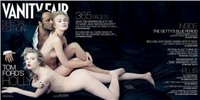 The cover of Vanity Fair’s March 2006 Hollywood issue shows actresses Keira Knightley and Scarlett Johansson posing nude together with the fully dressed fashion designer and guest editor Tom Ford.
The cover of Vanity Fair’s March 2006 Hollywood issue shows actresses Keira Knightley and Scarlett Johansson posing nude together with the fully dressed fashion designer and guest editor Tom Ford.Even before publication, the cover raises many eyebrows.
Why is a magazine cover in general so important?
“Vanity Fair” is one of the many magazines that need to attract readers.
If an issue in this cutthroat magazine industry sells more than 30 percent of its copies it’s considered to be a success. Every copy sold above that is money in the bank.
The trick is to grab first-time buyers at the newsstand within their 2 1/2 seconds attention span.
The best way to ensure this is a hot cover.
“The cover is your calling card; people are making a split-second decision, do it’s got to be compelling,” confirms Will Dana, managing editor of Rolling Stone magazine.
(“Rolling Stone” has produced memorable covers over the years, including the one showing a nude John Lennon wrapped around a clothed Yoko Ono)
But even before the “Vanity Fair” Hollywood issue hit the newsstands, it already created media frenzy and rekindled the age-old debate “female vs. male nudity”.
Apart from the racy cover, famed (female) photographer Annie Leibovitz shot a 46-page photo spread for the issue in which actresses Sienna Miller, Angelina Jolie, Jennifer Aniston, and Joy Bryant also appear in various states of nudity.
The photographed male actors are all dressed, including George Clooney amid a bevy of women in flesh-toned underwear.
This leads to the question: is this arty and fun, or does it say something about sexual politics in Hollywood?
And does a serious actress still need to take her clothes off to get attention?
According to Janice Min, editor of the much-read celebrity magazine US Weekly, female stars disrobe since they have to be sexy to be a successful and bankable. Men on the other hand are
not viewed as sex objects in the same way that women are.
Journalism professor Samir Husni of the University of Mississippi claims that Americans have been trained to look at pictures of naked women, but not of naked men.
The American public has therefore an inherent fear of pictures of naked men.
He goes on calling the Vanity Fair issue a "Playboy" issue, since it sports naked women.
He agrees that the magazine has scored huge buzz, though.
He is not alone in that observation – famed society columnist Liz Smith wrote about a dinner party where people were passing the issue around, declaring it “ridiculous ... egotistical ... absurd”.
Vanity Fair spokeswoman Beth Kseniak said it’s too early to say how the magazine will sell, but that it has scored about 3,000 new subscriptions and almost 5 million web site page views before the end of February 2006 alone.
Some of that buzz has been negative, of course.
Vitriolic Rebecca Traister calls the cover an “over-the-top orgy of self-love, misogyny and idiocy” by Ford (who came up with the concept) in salon.com.
Since the cover is so buzz-worthy, US Weekly conducted a poll and asked its readers about their opinion.
The result: most thought the actresses looked better with clothes on.
(It would be interesting to know the age and gender of the interviewees).
No matter what you viewpoint on naked females (or males) on magazine covers is, “Vanity Fair” created wonderful PR with its cover thus increasing its sales figures.
So you see, sex still sells and that’s the naked truth!
No comments:
Post a Comment